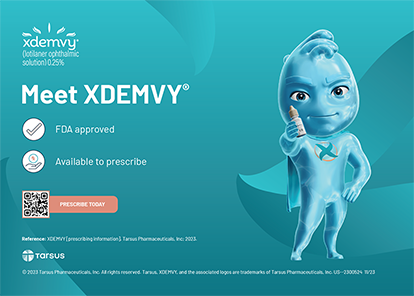
The most important “take-home” message about laser vision correction (LVC) enhancements after cataract surgery is to avoid needing them. In the age of refractive cataract surgery as patients’ desire to lead a spectacle-free life continues to grow, precise refractive outcomes after cataract surgery are key to success.
SUBOPTIMAL OUTCOMES
Efforts to improve postoperative refractive results for cataract patients have traditionally focused on optimizing preoperative biometry measurements and IOL power prediction formulas. Even with the most advanced preoperative calculations, including noncontact biometry, the average of multiple corneal power measurements, and the optimization of surgeon-specific A-constants, however, suboptimal refractive results still are not uncommon. In the hands of the most experienced surgeons, only 80% of eyes achieve a result within ±0.50 D of the intended spherical target.1 Larger deviations from the intended target are routine in patients with high myopia,2 high hyperopia, or a history of prior corneal refractive surgery3,4 and in those in whom biometry is impossible for reasons such as a white or dense posterior subcapsular cataract. Ocular surface disease as well as anterior corneal dystrophies causing corneal staining and irregularity can also significantly change keratometry values. Treating conditions that affect the central 4 mm of the cornea prior to cataract surgery and then repeating biometry are therefore critical to obtaining the most accurate measurements.
In addition to the potential for suboptimal spherical equivalent outcomes, an estimated 15% to 29% of patients presenting for cataract surgery have more than 1.50 D of corneal astigmatism, and 60% or more have at least 0.50 D.5-7 Residual refractive astigmatism after cataract surgery can affect patients’ UCVA and cause significant visual disturbances, including blur, halos, and ghosting. This is especially true if multifocal IOLs are implanted,8,9 when residual refractive astigmatism may have a significant negative impact on uncorrected near acuity. For these reasons, the management of corneal astigmatism has become an important aspect of surgical planning for cataract surgery.
INTRAOPERATIVE ABERROMETRY
The goal of intraoperative aberrometry is to optimize surgical results in terms of both the spherical equivalent and astigmatism. This technology also allows surgeons to refine spherical and toric IOL power selection as well as the axial placement of toric IOLs. Moreover, intraoperative aberrometry measurements facilitate detection of the posterior corneal contribution (most commonly against the rule) to a patient’s total corneal astigmatism, thereby helping to avoid inadvertent errors in toric IOL power selection.
At a Glance
• The most important “take-home” message about laser vision correction enhancements after cataract surgery is to avoid needing them. Intraoperative aberrometry is a valuable means to this end.
• Despite cataract surgeons’ best efforts, enhancements remain a necessary and useful tool when outcomes are not as predicted.
• It is important to allow adequate time for surgical healing and to address other ocular conditions prior to proceeding.
Ianchulev et al demonstrated the advantage of intraoperative aberrometry compared with standard biometry for eyes with a history of LVC.4 These investigators showed a statistically significant increase in the accuracy of the predicted mean residual spherical equivalent with aberrometry compared with control.
As correcting astigmatism at the time of cataract surgery with toric IOLs and limbal relaxing incisions (LRIs) has become more popular, patients’ expectations regarding their postoperative UCVA have risen, thus increasing the use of LVC to reduce residual refractive astigmatism. In a retrospective study by Packer,10 the use of intraoperative aberrometry to guide the placement of LRIs reduced the frequency of subsequent LVC to treat residual cylinder compared with cases in which intraoperative aberrometry was not used. Recently, my colleagues and I compared results with intraoperative aberrometry to standard nonaberrometry techniques with online toric calculators. We found that patients receiving toric IOLs were 2.4 times more likely to have less than 0.50 D of residual refractive astigmatism when aberrometry was used compared to the standard techniques.11
ENHANCEMENTS
Counseling
Despite cataract surgeons’ best efforts, enhancements remain a necessary and useful tool when outcomes are not as predicted. During their preoperative consultation, all patients in my practice who will receive a toric or multifocal IOL and/or undergo laser cataract surgery with LRIs are counseled about their potential need for LVC or an astigmatism-adjusting procedure after surgery.
Considerations
Prior to performing an enhancement, it is important to consider the following:
• Has the eye completely healed from cataract surgery? This includes incisions as well as the resolution of inflammation and corneal edema.
• Do any other ocular conditions need to be addressed prior to a laser enhancement? Examples include dry eye disease and cystoid macular edema.
• Has a YAG capsulotomy been performed?
• Is the patient’s postoperative refraction stable?
To allow for healing, improvement, and refractive stabilization, I often wait approximately 3 months before considering a laser enhancement.
How I Proceed
Before proceeding with an enhancement, I perform a YAG capsulotomy if it was not done previously to ensure that posterior capsular opacification or wrinkling is not interfering with the patients’ refraction or causing his or her symptoms. The patient returns 1 to 2 weeks after the YAG capsulotomy for a refractive evaluation, which involves extensive testing such as a full examination, the manifest refraction, topography, tomography, and evaluation with the OPD III (Nidek).
The options for LVC treatment after cataract surgery are LASIK and PRK. In the setting of multifocal IOLs, my preference is PRK, because I believe there is a theoretical risk that the LASIK flap interface will produce an undesired effect on the optical pathway, increasing dysphotopsia. I consider an astigmatic keratotomy or LRIs for astigmatic correction when the mean postoperative spherical equivalent is plano.
CONCLUSION
Precise preoperative measurements and intraoperative aberrometry help prevent the need for enhancements after cataract surgery, but LVC remains a necessary and useful tool for optimizing outcomes. It is important to allow adequate time for surgical healing and to address other ocular conditions prior to proceeding with an enhancement. n
1. Hahn U, Krummenauer F, Kolbl B, et al. Determination of valid benchmarks for outcome indicators in cataract surgery: a multicenter, prospective cohort trial. Ophthalmology. 2011;118(11):2105-2112.
2. Ghanem AA, El-Sayed HM. Accuracy of intraocular lens power calculation in high myopia. Oman J Ophthalmol. 2010;3(3):126-130.
3. Canto AP, Chhadva P, Cabot F, et al. Comparison of IOL power calculation methods and intraoperative wavefront aberrometer in eyes after refractive surgery. J Refract Surg. 2013;29(7):484-489.
4. Ianchulev T, Hoffer KJ, Yoo SH, et al. Intraoperative refractive biometry for predicting intraocular lens power calculation after prior myopic refractive surgery. Ophthalmology. 2014;121(1):56-60.
5. Mendicute J, Irigoyen C, Aramberri J, et al. Foldable toric intraocular lens or astigmatism correction in cataract patients. J Cataract Refract Surg. 2008;34:601-607.
6. Lopez-Gil N, Montes-Mico R. New intraocular lens for achromatizing the human eye. J Cataract Refract Surg. 2007;33:1296-1302.
7. Hoffer KH. Biometry of 7,500 cataractous eyes. Am J Ophthalmol. 1980;90:360-368.
8. de Vries NE, Webers CA, Touwslager WR, et al. Dissatisfaction after implantation of multifocal intraocular lenses. J Cataract Refract Surg. 2011;37(5):859-865.
9. Zheleznyah L, Kim MJ, MacRae S, Yoon G. Impact of corneal aberrations on though-focus image quality of presbyopia-correcting intraocular lenses using an adaptive optics bench system. J Cataract Refract Surg. 2012;38(10):1724-1733.
10. Packer M. Effect of intraoperative aberrometry on the rate of postoperative enhancement: retrospective study. J Cataract Refract Surg. 2010;36(5):747-755.
11. Hatch KH, Woodcock EC, Talamo JH. Intraocular lens power selection and positioning with and without intraoperative aberrometry. J Refract Surg. 2015;31(4):237-242.
Kathryn M. Hatch, MD
• member of the faculty in ophthalmology, Harvard Medical School, Massachusetts Eye and Ear Infirmary Waltham
• (781) 890-1023; kathryn_hatch@meei.harvard.edu


